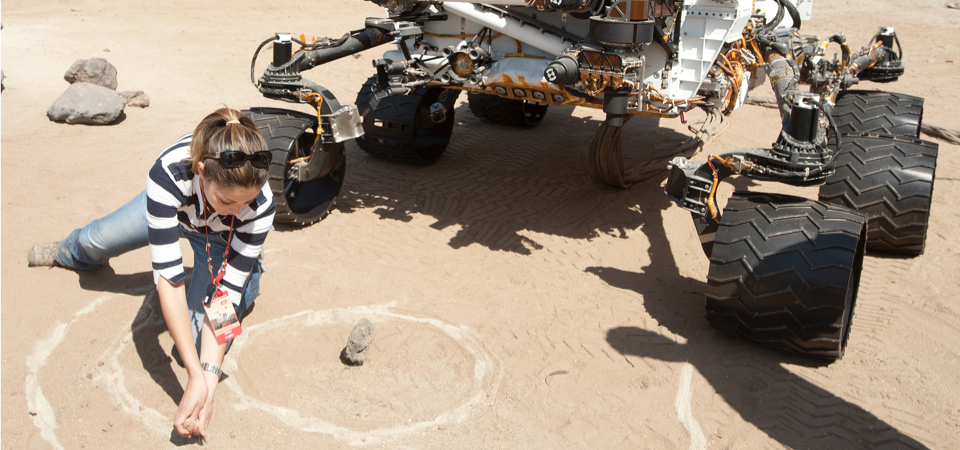ABET Accreditation
Aerospace Engineering Program Mission, Vision, Outcomes, and Degree Data
The Engineering Accreditation Commission of ABET accredits our Aerospace Engineering program.
The Mission of the Aerospace Engineering Program is to provide education by hands-on application of theory to produce graduates for a diverse society who can contribute immediately, effectively, and ethically to the development of aerospace products and possess the educational foundations for their career growth in the industry, and academia, with innovation and leadership.
The Vision of the Aerospace Engineering Department is to produce nationally recognized aerospace graduates who can contribute to achievements in national defense, space exploration, commercial aerospace, aeronautics, and academia.
The graduates of Aerospace Engineering will be practicing professionals who exhibit these Program's Educational Objectives.
-
Demonstrate their knowledge of aerodynamics, aerospace materials, aircraft and spacecraft structures, aircraft and space propulsion, flight mechanics, stability and control systems, orbital mechanics, space environment, attitude determination and control, telecommunications, and design competence of aircraft and spacecraft using systems engineering principles;
-
Apply a hands-on application of theory in a laboratory, field experience, and independent study opportunities involving teamwork and exposure to modern engineering analytical and computational tools;
-
Utilize a comprehensive educational foundation that emphasizes application-based analysis and problem-solving, exposure to open-ended problems and engineering while fostering teamwork, communication skills, innovation, leadership, lifelong learning skills, and individual ethical professionalism in graduate studies and careers in aerospace engineering.
Students desiring to major in Aerospace Engineering need a particularly high aptitude for science and mathematics. Incoming first-year students should have completed substantial college preparatory courses in these disciplines in high school. Incoming transfer students should have completed at least one year of college calculus and one year of college physics (with laboratory) before beginning the program at Cal Poly Pomona. Community college students planning to transfer into this department should consult a school counselor or department to determine which courses meet the program requirements.
The Student Outcomes at the time of graduation are:
-
An ability to identify, formulate, and solve complex engineering problems by applying principles of engineering, science, and mathematics.
-
An ability to apply engineering design to produce solutions that meet specified needs with consideration for public health, safety, and welfare, as well as global, cultural, social, environmental, and economic factors.
-
An ability to communicate effectively with a range of audiences.
-
An ability to recognize ethical and professional responsibilities in engineering situations and make informed judgments, which must consider the impacts of engineering solutions in global, economic, environmental, and societal contexts.
-
An ability to function effectively on a team whose members together provide leadership, create a collaborative and inclusive environment, establish goals, plan tasks, and meet objectives.
-
An ability to develop and conduct appropriate experimentation, analyze and interpret data, and use engineering judgment to draw conclusions.
-
An ability to acquire and apply new knowledge as needed, using appropriate learning strategies.
Aerospace engineering students are encouraged to become active in the student branch of the American Institute of Aeronautics and Astronautics, a national society organized for the advancement of aerospace knowledge. Qualified students are invited to join the student chapter of Sigma Gamma Tau, the national aerospace engineering honor society.
|
Academic Year |
Enrollment Year |
Total Undergrad |
Total Grad |
Degrees Awarded |
||||||||
|
1st |
2nd |
3rd |
4th |
5th |
Associates |
Bachelors |
Masters |
Doctorates |
||||
|
2022-2023 |
FT* |
130 |
95 |
112 |
282 |
|
619 |
|
|
TBD |
|
|
|
PT** |
3 |
6 |
21 |
76 |
|
106 |
|
|||||
|
2021-2022 |
FT |
84 |
74 |
111 |
320 |
|
589 |
|
|
161 |
|
|
|
PT |
4 |
10 |
27 |
86 |
|
127 |
|
|||||
|
2020-2021 |
FT |
65 |
64 |
139 |
301 |
|
569 |
|
|
96 |
|
|
|
PT |
1 |
8 |
18 |
53 |
|
80 |
||||||
|
2019-2020 |
FT |
52 |
93 |
148 |
253 |
|
546 |
|
|
109 |
||
|
PT |
|
6 |
15 |
44 |
|
65 |
|
|||||
|
2018-2019 |
FT |
57 |
127 |
112 |
234 |
|
530 |
|
|
113 |
|
|
|
PT |
3 |
2 |
13 |
57 |
|
75 |
|
|||||
* FT—full-time
** PT—part-time
